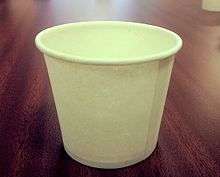Disposable cup


.jpg)
A disposable cup is a type of disposable tableware and disposable food packaging. Disposable cup types include paper cups, plastic cups and foam cups.[1][2] Expanded polystyrene is used to manufacture foam cups,[3] and polypropylene is used to manufacture plastic cups.[4]
As they are produced for single use, disposable cups and other similar disposable products constitute a major source of consumer and household waste,[5] such as paper waste and plastic waste. It has been estimated that the average household discards around 70 disposable cups every year.[5]
US consumption is some 108 billion cups per year,[6] the UK uses an estimated 2.5 billion paper cups every year.[7]
History
The disposable cone-shaped paper cup was invented in 1908 by Lawrence Luellen, and in 1912 Luellen and Hugh Moore began marketing the Health Kup, another paper disposable cup.[8] The Health Kup was designed to create a means for people to drink water from public water barrels without spreading germs, which occurred when people would use a dipper or their own cup to hold the water.[8] The Health Kup was later renamed to Dixie Cup, and was named after a brand of dolls.[8] Luellen and Moore later developed a disposable paper ice cream cup, which included lids with images of sportspeople, movie stars and animals.[8]
Commercial uses
Some companies, such as coffee retailers[9] and doughnut shops,[10] sell their products in disposable cups. A 2011 book estimated that a chain of doughnut shops used one billion disposable coffee cups in a year, enough to circle the Earth twice.[10] A 2012 article in OnEarth said that Starbucks used over four billion disposable coffee cups in 2011.[11] The Cup Noodles brand of instant noodles uses expanded polystyrene foam cups to contain the product.[12] Hot or boiling water is added to the dried noodles in the container, which cooks the product in a few minutes.[12] Nissin Foods began marketing the product in foam cups in the early 1970s.[13]
Pollution
The manufacturing of paper cups contributes to water pollution when chemicals such as chlorine, chlorine dioxide and reduced sulfides enter waterways.[2] The manufacturing of foam cups contributes to air pollution when pentane is released into the air.[2]
Recycling and other environmental measures
The curbside recycling of polypropylene containers has slowly increased in some developed countries, but is still rather limited.[4]
McDonalds switched from foam cups to paper cups in 2014,[6] and is moving to recycle paper cups in the UK, as of 2016, in partnership with Simply Cups and James Cropper.[14]
See also
References
- ↑ Hill, M.K. (2010). Understanding Environmental Pollution. Cambridge University Press. p. 519. ISBN 978-1-139-48640-8.
- 1 2 3 Worrell, W.A.; Vesilind, P.A.; Ludwig, C. (2016). Solid Waste Engineering: A Global Perspective. Cengage Learning. p. 395. ISBN 978-1-305-88835-7.
- ↑ Webster, K. (2000). Environmental Management in the Hospitality Industry: A Guide for Students and Managers. Environmental Management in the Hospitality Industry: A Guide for Students and Managers. Cassell. p. 146. ISBN 978-0-304-33234-2.
- 1 2 Szaky, T. (2014). Outsmart Waste: The Modern Idea of Garbage and How to Think Our Way Out of It. BK currents book. Berrett-Koehler Publishers. p. pt70. ISBN 978-1-62656-026-0.
- 1 2 Zimring, C.A.; William L. Rathje, C.E. (2012). Encyclopedia of Consumption and Waste: The Social Science of Garbage. SAGE Publications. p. pt1026. ISBN 978-1-5063-3827-9.
- 1 2 http://dismalscience.journalism.cuny.edu/2014/04/13/mcdonalds-switch-to-paper-cups-source-of-new-demand-for-international-paper/
- ↑ http://www.ciwm-journal.co.uk/mcdonalds-uk-to-trial-plastic-coated-paper-cup-recycling/
- 1 2 3 4 Aydelott, J.; Buck, D. (2007). Read Write Respond Using Historic Events. Teacher Created Resources. p. 89. ISBN 978-1-4206-8237-3.
- ↑ Chronicle, San Francisco (November 13, 2015). "Much ado about a Starbucks disposable cup". San Francisco Chronicle. Retrieved April 16, 2016.
- 1 2 Miller, G.T.; Spoolman, S. (2011). Cengage Advantage Books: Sustaining the Earth. Cengage Learning. p. 288. ISBN 978-1-133-16928-4.
- ↑ Palmer, Brian (April 2, 2012). "Meet the Change Makers: Starbucks's Quest for a Better Cup". OnEarth Magazine. Retrieved April 19, 2016.
- 1 2 Roe, M. (2004). Market Research in Action. Thomson Learning. pp. 64–65. ISBN 978-1-86152-938-1.
- ↑ Harlan, J. (2011). Ramen to the Rescue Cookbook: 120 Creative Recipes for Easy Meals Using Everyone's Favorite Pack of Noodles. Ulysses Press. p. pt11. ISBN 978-1-61243-004-1.
- ↑ http://www.ciwm-journal.co.uk/mcdonalds-uk-to-trial-plastic-coated-paper-cup-recycling/
Further reading
| Wikimedia Commons has media related to Disposable cups. |
- Pertinent Characteristics of the Disposable Cup Industry as Related to Area Redevelopment. ARA staff study. The Administration. 1964. (subscription required)